-
29/09/2022
Virtual Galleries, Actual Institutions
Panel with Robin Stethem and Lívia Nolasco-Rózsás
Online, Thursday September 29, 2PM EST
Register freeDo virtual galleries exist after the system stops running? In this closing panel of the Museums Without Walls’ online program, we will address how simulated and immersive environments may be the cornerstone for larger institutional operations, underpinning anything from cultural preservation to providing shared frames of reference and enabling consistent forms of assemblage between actors both human and non-human. The discussion will feature the participation of representatives of Museum of Other Realities, a Vancouver-based enterprise, and Beyond Matter, a project led by the Zentrum für Kunst und Medien Karlsruhe.
The Museum of Other Realities (MOR) is an immersive multiplayer art showcase in virtual reality. It contains a growing collection of interactive art and experimentation, covering everything from 3D paintings to fully-fledged narrative experiences. Lately, besides displaying works from its own collection, MOR has been working in partnership with a number of renowned film festivals, such as the Vancouver International Film Festival, Tribeca Film Festival, and the Cannes Film Festival, to host their immersive media programs.
Beyond Matter is an international, collaborative, practice-based research project that takes cultural heritage and culture in development to the verge of virtual reality. It does this by reflecting on the virtual condition with a specific emphasis on its spatial aspects in art production, curating, and mediation via numerous activities and formats, including the digital revival of selected past landmark exhibitions, art and archival exhibitions, conferences, artist residency programs, an online platform, and publications. This common undertaking seeks to engage with a contemporary shift — largely attributable to the rapid development and ubiquitous presence and use of computation and information technology — in the production and mediation of visual art within institutional frameworks.
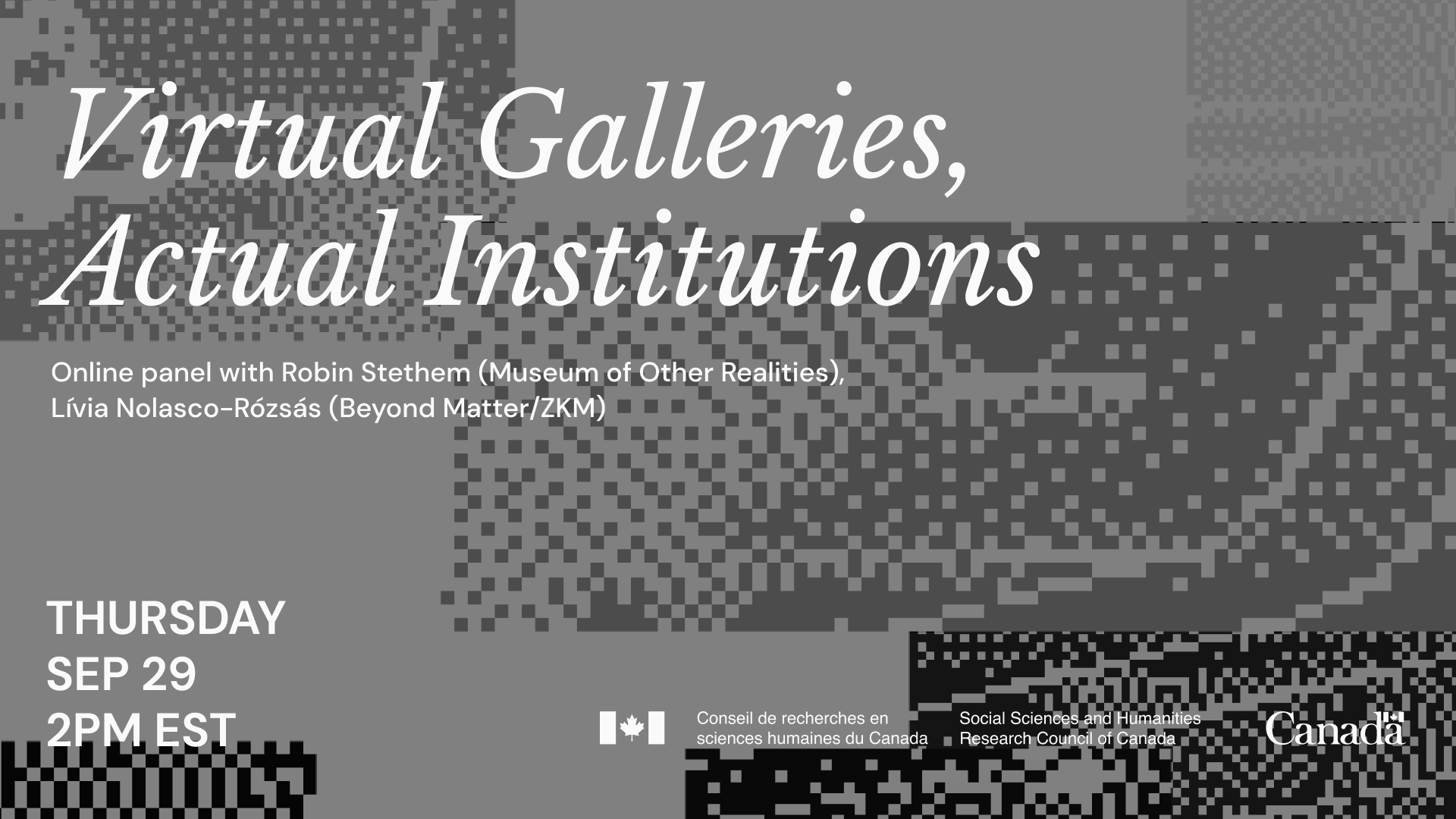
-
22/09/2022
Panel “Performing Collections”
Panel with Ashley Lanni, Le Thu Mach & Nguyen Thi Bao Ngoc, Hoyee Tse, and Stéphanie Bertrand
Online, Thursday September 22, 2PM EST
Register free
A Museum for Contemplation: A Comparative Study between Imagine Monet and the Musee L’Orangerie’s Water Lilies
Ashley Lanni (University of Toronto, Canada)Immersive environments are a mainstay of emerging art galleries and exhibitions. From VR experiences to floor-to-ceiling screen installations, contemporary museum goers gravitate to spaces that promise content that is an alternative to the classically static and distant museum-going experience. This presentation compares the Monet exhibit at the L’Orangerie museum in Paris, France and the Imagine Monet exhibition that recently passed through Montreal, Canada. In contrasting these two exhibits, we will look at the power of immersion and contemplation in spaces of artistic installation and show the ways in which progressive and immersive spatial design is not necessarily synonymous with technology. At the core of the discussion will be how “technology” works in making a visitor a part of the curated experience, and the importance of active participation in immersion. In other words, the presentation will look to answer what precisely works and doesn’t work when creating a technologically immersive experience. As Monet put it, “people must first of all learn to look at nature, and only then may they see and understand what we are trying to do.” The immersive exhibit should teach the visitor to gaze, rather than do the gazing for them. - WATCH HERE
The Digitalization in Museums in Vietnam: The Curation of New Media
Dr. Le Thu Mach (Ho Chi Minh National Academy of Politics, Vietnam), Nguyen Thi Bao Ngoc (Vietnam Fine Arts Museum, Vietnam)The digitalization in museums in Vietnam started before the COVID-19 pandemic, and has been further accelerated during the pandemic. This includes the use of websites, apps, producing contents for social media pages, and other new media tools for museum curation, both in museums and on the Internet environment. Vietnam has a young and tech-savvy population who are willing to shift from physical visits to virtual visits to museums. Using the feedback of visitors of Vietnam Fine Arts Museum, and the in-depth interviews with the museum staff, this paper describes the digitization in museums in Vietnam and analyses the effectiveness of the types of contents to be curated on digital tools. The paper also explores the use of new media among different groups of museum visitors, including the youth, the middle-aged, and the elderly; Vietnamese and foreigners. It also analyses the growth in the number of museum app users of Vietnam Fine Arts Museum. The authors discuss the changes in regulations and policies to facilitate the digitalization in museums in Vietnam. Lessons learnt from the early stages of digitalization in museums in Vietnam can contribute meaningfully to the understanding of digitalization and museum management in the Global South.
Digitalising Community Engagement and Co-curation of Local Design Culture
Hoyee Tse (Royal College of Art, United Kingdom)This paper explores in what ways curators can utilize online platforms, such as Mozilla Hubs, to co-curate local design collections. This curation-led research aims at promoting the acknowledgement of local design objects and culture in shaping socio-cultural identity through the use of online platforms that supports simultaneous navigation, live audio conversation, and uploading of multidimensional objects and multimedia materials. My methodology is to experiment on a community-engaged co-curating model with the digital platform. I conduct a series of community-engaged digital curatorial activities and interviews in which local community members in London share their design objects, which they find representative of their local culture and memories, to the Hubs space. Through these individual interviews, I collect qualitative data from the members on why they select the objects and how they curate the digital space. My analysis examines to what extent digital platforms can make museum collecting and curatorial practices more transparent and interactive for its audience while empowering them in the collection decision making process. It gives an insight into the opportunities that Mozilla Hubs has for collecting local memories and objects as well as the challenges to sustain digital engagement from local communities in co-curating museum collections. - WATCH HERE
Recruiting Collective Intelligence to Level Art World Stratification: How Virtual Museums Can Impact the Actual Art System
Stéphanie Bertrand (Concordia University, Canada; ICS-FORTH, Greece)Departing from one of the five key cultural impacts of physical museums, this talk explores an important virtual benefit of online digitized art collections. The claim is that these increasingly interconnected collections have the potential to transform the art system’s inherent stratification, viz. modulate the art world’s access barriers to institutional prestige, thus benefiting artists by leveling the playing field. They can serve as a digital infrastructure to recruit collective intelligence on a mass scale in order to offset the perverse effects of the art world’s gatekeeping mechanisms, and foster more equality and diversity in the milieu. However, this impact cannot simply be achieved by turning users into citizen curators or leveraging “altmetrics” (views and likes) to influence selection and modulate order within an aggregated or distributed database. The main obstacle to this impact is not online access barriers nor insufficient participation. Multiplying eyeballs, facilitating discovery and promoting public choices are all vital; but these initiatives cannot hope to transform the system if the individual judgment being captured is subject to network effects driving inequality. To surpass these effects, the talk concludes by proposing a novel, choice-based, pathfinding navigational tool designed to recruit users’ sensemaking faculty as opposed to their personal taste. - WATCH HERE

-
15/09/2022
Panel “Sites of Exhibition”
Panel with Laura Cocciolillo, Daniel Hora, Karyne Berger Miertschink & Larissa Pereira, Roselinde Bon, and Sojung Bahng, Vincent Dziekan & Jon McCormack
Online, Thursday September 15, 2PM EST
Register free
Galleries in Simulated Virtual Environments: the Case of Ars Virtua
Laura Cocciolillo (Ca’ Foscari University, Italy)We are witnessing a transition from a “readability” of the image to a “playability” of the environmental image: this is reconfiguring the art spaces and transposing them in shared virtual environments. Questioning the relationship between museums and online platforms reveals the assumption that real and virtual are two opposite conditions, while they are actually two sides of the same coin. Does the virtual need the real or does the real need the virtual? In the hypervisual environment that characterizes the contemporary era, one needs the other and vice versa. Rather, the purpose of this essay is to focus on the simulated virtual environments that since nearly two decades have demonstrated to be a privileged arena for experimenting with truly fluid and malleable possibilities for exhibitions, built without the physics rules of the “off-world”. Tracing the history of one of the most interesting exhibition venues in a virtual environment, Ars Virtua Gallery, a New Media Center and Gallery located primarily in the synthetic world of Second Life, this dissertation explores the potentials and limitations of an art space entirely settled in a simulated social environment. - WATCH HERE
Art Curating and Aesthetics in the Metaverse: An Essay About Art Exhibitions on Virtual Platforms
Daniel Hora, Karyne Berger Miertschink & Larissa Pereira (Federal University of Espírito Santo, Brazil)In this essay we comment on some factors involved in curatorial activities and the aesthetic experience of visual arts, as observed in practices of exhibition on virtual platforms. The first case to be presented is the sandbox-building, AI-driven MMO game Occupy White Walls, that intitles itself as an artiverse. The game gathers images from museums' collections licensed by agreement or available in public domain, in addition to original artworks sent by users. The participants' interaction involves the exhibit spaces configuration, and the acquisition of pieces, freely chosen by players or oriented by the Artificial Intelligence DAISY. This algorithmic assistance enhances the gameplay but also presents the risk of reinforcing taste patterns (MANOVICH, 2018). The Wrong Biennale, in turn, articulates itself as a network of virtual and physical exhibitions of digital art. In its last edition (2021-2022), the project included pavilions in spaces of virtual immersion structured on various platforms. As examples, we can mention projects such as Notland (SIMMER.io), Techspressionism (Kunstmatrix), My Mother Was a Computer (New Art City), and Re-Significados (Metaverso:Binaria). These cases allow us to observe how art curating and its reception are conditioned by different options, with their respective degrees of technological, social, and economic structuring. - WATCH HERE
Youseum: Museum as Infrastructural Mashup the Sponsored Crisis of Materiality: Negotiating the Art Industry and the Platform Economy
Roselinde Bon (University of Amsterdam, Netherlands)Using the Youseum in Amsterdam as a case study, I argue that within the physical space of the Instagram museum, material urban environments and immaterial social media cultures become increasingly entangled. The remixing of picture-perfect, occularcentrist Instagram aesthetics in a physical museum reiterates Juhani Pallasmaa’s conceptualisation of the rise of “retinal art” in the urban realm. Aesthetics that were popularized through photographic squares in two-dimensional feeds are now translated into “three-dimensional visual images in space.” Through physical adaptations of online aesthetics and an emphasis on the transmedial expression of a social self(ie), boundaries become blurred. Just like social media weave “pre-defined communicative acts” like sharing and liking into an “economic logic”, Instagram museums predefine visiting and “gramming” sponsored rooms as an interaction with corporate interests. Tracing this negotiation between art industry and platform economy as embodied by the Youseum, I propose that rather than a purely digital “plug in,” the pop-up Instagram museum is a “product of interoperability”, an infrastructural “mashup” of its own kind. Adapting the two-dimensional aesthetic and logic of Instagram for a three-dimensional urban space has the potential to reconceptualize virtual art as an embodied and interactive experience. - WATCH HERE
Reflexive-vr.com: Reconfiguring a physical VR exhibition into an online virtual exhibition due to the COVID-19 pandemic
Sojung Bahng (Queen’s University, Canada), Vincent Dziekan & Jon McCormack (Monash University, Australia)This paper reviews a virtual exhibition titled reflexive-vr.com. Initially planned as a public exhibition featuring cinematic VR works by media artist/filmmaker Sojung Bahng, due to restrictions imposed by the COVID-19 pandemic, a different curatorial approach was needed in order to reconfigure the original installation plan into an interactive online viewing experience. This reflective analysis explores the design strategies involved in this case and how the viewing experiences associated with the artistic intent of three VR artworks (Floating Walk, Anonymous and Sleeping Eyes) was supported by the exhibition's translation from a gallery-based installation into an online virtual environment. We will address technical specifications, consider curatorial strategy and implications to narrative flow and phenomenological experience, and – while acknowledging present limitations – raise the potential for online exhibition formats to serve as a distinctive presentational mode in their own right for engaging viewers with VR works. - WATCH HERE

-
08/09/2022
Panel “Institutional Leaks”
Panel with Antoinette LaFarge, Karin de Wild & Nadezhda Povroznik, Lia Carreira, and Rene G. Cepeda
Online, Thursday September 08, 2PM EST
Register free
Fictive Museums: Artist as Institution
Antoinette LaFarge (University of California Irvine, USA)Visual artists spend part of their career negotiating entry into the museum, usually through intermediaries (curators, collectors). Frustration with this top-heavy system has led artists to push back, and this dissatisfaction has led another cadre of artists to become institutions, launching their own museums and archives. As I discuss in my recent book Sting in the Tale: Art, Hoax and Provocation, these conceptual museums do not conform in such basic matters as having a physical site, a permanent collection, or a professional staff. Instead, they exist largely to question where the museum's essential identity lies and who gets to make that determination. The advent of the internet launched a wave of fictive institutions existing and operating primarily on the web, like Clair Le Couteur’s John Affey Museum, but now embracing a much wider range of institutional types. Whether considered hoaxes, facades, or “real” institutions, they underline some of the key problematics of traditional museums while suggesting possible paths forward, not all of which may be considered culturally acceptable. For this conference, I will give an overview of the history of fictive institutions and discuss the ways in which they creatively respond to the idea of the museum and its place in western culture. - WATCH HERE
Museums on the Web: Exploring the Past for the Future
Karin de Wild (Leiden University, Netherlands) & Nadezhda Povroznik (Perm State University, USA)Within this talk we like to introduce some foundational work by the early Internet pioneers, as well as ruptures and continuities throughout the history of Museums on the Web. Through that, we’d like to introduce the upcoming Special Issue for the journal Internet Histories. This issue welcomes scholars and museum practitioners to discuss histories of museums on the Web. How have online collections been built, circulated, and exhibited? How did (information) architecture and museum websites develop over time? And how did museums build and engage with (online) communities? The main objective of this Special Issue is to reflect on the past to prepare for the future. Due to the COVID-19 pandemic, museums enhanced their digital activities and the importance of the Web to engage with audiences was felt throughout the sector. Furthermore, in today’s fast-changing digital landscape, museums are facing new challenges such as the rise of AI and the semantic Web. By engaging with the past, we can enhance our understanding of how museums are functioning today and offer new perspectives for future developments. - WATCH HERE
A Palace, a Street Router and a Digital Arts Museum: on the Palais des Beaux Arts Wien
Lia Carreira (Southampton University, United Kingdom)The Palais des Beaux Arts Wien is a digital museum located at the corner of Löwengasse 47a in Vienna. Created in 2014 by artist Bernhard Garnicnig, the museum dedicated to digital art was accessed only through a local router hidden in a shop across the street. To enter the museum, one had to physically stand with a mobile device within the router’s perimeter. Initially described as a “historic site for future-thinking art,” the project challenged the notions of what constitutes a museum and exhibition space by establishing an on-site museum without walls. In the early twentieth-century, the building itself housed the Atelier Bachwitz, a publishing house for the production and distribution of fashion and lifestyle magazines, which would later be seized by the Nazi regime. Now under the artistic direction of Seth Weiner, the institution shines a new light on this historical past and sets to discuss the multiple layering of the concepts of appropriation and occupation which has been cast upon the physical building throughout the decades. In this presentation, I will cover the development of the institution, highlighting the parallels between the digital and physical spaces of the museum and their appropriations. - WATCH HERE
Corporate Prudishness and its Challenges on Alternative and Minority Culture Virtual Exhibitions
Rene G. Cepeda (UNARTE, Mexico)From censoring artistic nudity to profanity filters, corporate censorship stifles artists and their works and by extension the creative scope of exhibitions by limiting the choice of platforms available. Examples of this include Facebook, Instagram and TikTok banning Vienna museums for posting nudes from their collections to the point the participating museums had to move to OnlyFans, a platform mostly known for sex work. More egregiously, queer, and disabled artists such as Robert Andy Coombs constantly find themselves hit with community guideline violations for content that heteronormative, able-bodied artists don’t. Furthermore, this limited access to the most popular and by extension more restrictive platforms reduces the reach and accessibility of virtual exhibitions. Not only that, but the necessity for commissioning custom platforms or in-house developments to replicate functionality available in pre-existing platforms elevates costs and reduces the creative and experimental power of online exhibitions. In this presentation I will address the challenges faced by curators and institutions when operating within those spaces and discuss possible ways out of this situation. - WATCH HERE

-
01/09/2022
Panel “Materials of Memory”
Panel with Yi Song, Olivia Ericksson, Emily Godden, and Lesley Johnston
Online, Thursday September 01, 2PM EST
Register free
Faces, Places: Constructing the Site of Memory through Participatory Art
Yi Song (University of Cambridge, United Kingdom)This article will investigate the role of participatory art in mediating memory of French villagers and empowering communities by examining the Inside Out Project and its documentary Faces, Places (2017). The documentary is co-directed by Agnès Varda and photographer JR, recording their art practices of creating portrait murals for ordinary people living in rural areas. Built on Nora’s (1989) site of memory, both the art project and the film can articulate chains of memory from the locals. This art practice actualises the ideal of “a museum without barrier”, and constructs an open space where different actors and media can avail themselves to make engagements and voices. In this context, memory can be deemed as the representation of the time lost and restored and the practice of presence and witness, reenchaining and invigorating the quotidian affairs and objects neglected by the official storytelling. More importantly, this participatory art project can evoke the fundamental issue of cultural identity both to the locals and a broader audience. This article also questions the purity of the site of memory by exploring subjectivities of artists in practice. - WATCH HERE
The Expanded Gallery Experience: Documentation and Simulated Presence in Olafur Eliasson’s Your Uncertain Archive
Olivia Eriksson (Stockholm University, Sweden)Installation works’ ability to envelop the spectator in a three-dimensional environment is often hailed as one of its essential traits. But what happens when this basic premise – the presence of the museum visitor and the “here and now” of the exhibition space – is abandoned for the sake of documentation? What becomes of the importance of participation when these artworks meet new demands for accessibility online?
The installation shot has been a staple feature when it comes to securing the legacy of exhibitions. Artists, as well as institutions, depend on such photographs for commercial purposes but also for making sure that artworks outlive their brief realization in the gallery in the form of a portfolio or as part of institutional memory. However, the moving image offers other possibilities for capturing the art experience in its fullness. Using internationally renowned installation artist Olafur Eliasson as an illustrative example, this presentation will consider the re-packing of his large-scale installation works in the ongoing art project “Your Uncertain Archive” [olafureliasson.net/uncertain] which gathers his artistic output in one (virtual) place, using video documentation and point of view shots to achieve the sense of being there, in the site of exhibition. - WATCH HERE
Playing the Past: Using WebXR to Rebuild the Lost City
Emily Godden (Anglia Ruskin University, United Kingdom)This research works with WebXR as it provides the functionality needed to bring both augmented and virtual reality to the web, enabling humans to use hardware they likely already have in their pocket, their smartphone to create immersive spaces. Introducing Mozilla Hubs is an immersive social experience that is delivered through the web browser Hubs is built using web standards meaning instead of being linked to a specific piece of hardware, Mozilla runs on most mixed reality headsets, from high end industry standard to a cardboard viewer or smartphone. To build the virtual environment for Hubs, Mozilla have kindly developed a web based online 3D scene editor called Spoke. In building an interface much like a games engine that can handle an array of file formats, the process of building interactive WebXR spaces for cultural heritage is accessible to anyone with a smartphone. A key aim of this research is to demystify the complexity of working with games engines and develop workflows custom-developed for working with tools already commonplace in digital heritage such as photogrammetry, 3D scanning and lidar. By leveraging the increasing affordances of games engines this research will work with tools already established in the area of digital heritage alongside new tools from immersive storytelling to ensure the virtual heritage outputs go beyond just reconstructions, but have story embedded throughout and enable interactivity across a range of digital devices. - WATCH HERE
Accessing the Antarctic through Storytelling and Immersive Technologies
Lesley Johnston (Anglia Ruskin University, United Kingdom)UK Antarctic Heritage Trust (UKAHT) preserves Antarctic heritage monument sites, six bases variously active between 1944 to present day. UKAHT, in an essential bid to increase Antarctic access and accessibility, is exploring the capability of VR for virtual heritage world-building through curated, historical, interactive, narratives and therein exhibiting the material history of place, art, or artefact. We aim to investigate if these experiences can surpass the novelty factor and become a viable long-term method to reach, engage, and inspire a global population. This presentation will showcase our current digital project undertaken with educational partners: digitising elements of our remote site, archive, and material heritage, and making them accessible and engaging to new audiences. We are weaving this digital content together with intangible heritage, layering the voices and evidence of the past over the material present to tell new stories. Through gamification and digital access to authentic artefacts we aim to encourage audiences to identify with, and reflect on, those who worked in these bases. Building empathy and understanding of the historic environmental and climate conditions faced in the past, we better comprehend the climate crisis the world faces now. - WATCH HERE
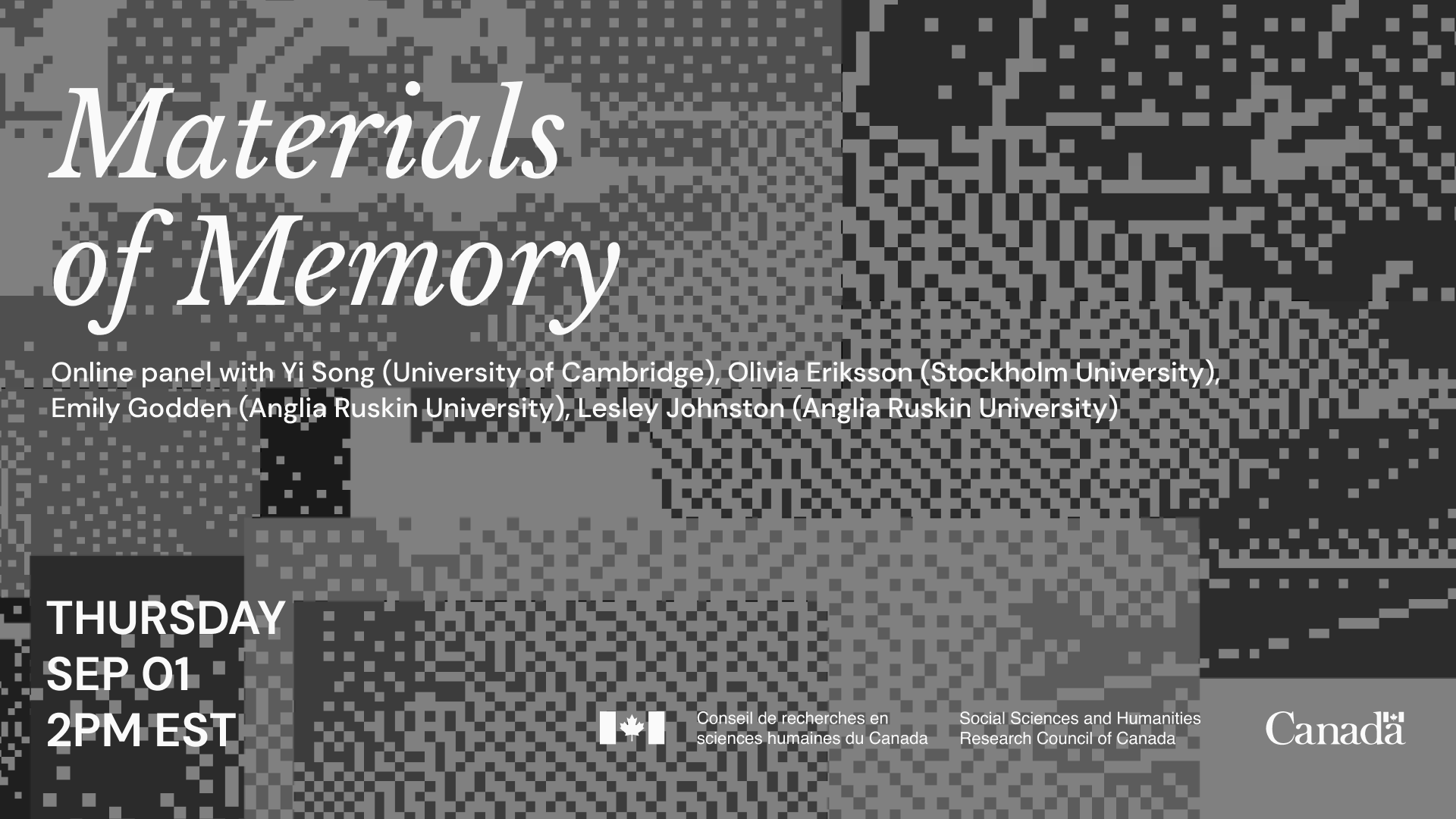
-
25/08/2022
Para-Academia, Post-Disciplinary Communities, and Networked Scholarship
Panel with Mohammad Salemy, Abbey Pusz, and Margo Bergamini
Online, Thursday August 25, 2PM EST
Register freeCommunities of knowledge outside of any pedagogic establishment have multiplied exponentially since the COVID-19 pandemic, in an explosion of online courses, collaborative syllabus, and self-directed study groups. This growth reflects not only an expansion of the possibilities offered by new communication technologies, but also a deeper crisis in academia. Universities became largely incapable of absorbing the very scholars and researchers they produce. All the while, fields like the humanities and social sciences struggle to stay relevant face increasingly complex political and cultural scenarios. Could networked scholarship represent a way to reanimate academia through more accessible, solidary, and, oftentimes, grounded forms of knowledge exchange? Or does it create dangerous precedents in times of rampant pseudoscience and fake news?
To mark the transition into the Museums Without Walls online program, we will be discussing these questions with representatives of two exceptionally active para-academic platforms: The New Centre for Research & Practice and Do Not Research (DNR). The New Centre is an international, non-profit, higher education institute in the Arts, Humanities, and Sciences, conceived upon the idea that the space of knowledge is a laboratory for navigating the links between thought and action as well as critique and construction. Its pedagogical approach bootstraps the conventional role of the arts, humanities, sciences, and technologies to construct new forms of research and practice alongside, within, and between technology. DNR is a collaborative platform for publishing writing, visual art, and beyond. Launched in 2021, DNR emerged from artist Joshua Citarella’s online chat community of artists and those otherwise concerned with contemporary online visual culture. It started as a community-led reading group centered around Mark Fisher’s Capitalist Realism, but soon encompassed a nexus of blog posts, artworks, and community workshops.
Mohammad Salemy is an independent Berlin-based artist, critic, and curator from Canada. He holds a BFA from Emily Carr University and an MA in Critical Curatorial Studies from the University of British Columbia. He has shown his works in Ashkal Alwan's Home Works 7 (Beirut, 2015), Witte de With (Rotterdam, 2015), and Robot Love (Eindhoven, 2018). His writings have been published in e-flux, Flash Art, Third Rail, Brooklyn Rail, Ocula, Arts of the Working Class, and Spike. Salemy's curatorial experiment For Machine Use Only was included in the 11th edition of Gwangju Biennale (2016). Together with a changing cast, he forms the artist collective Alphabet Collection. Salemy is the Organizer at The New Centre for Research & Practice. He has been the cofounding Organizer of The New Centre since 2014.
Abbey Pusz is an artist and writer interested in cultural currents particular to the left, its present disorientation, and the obstacles therefore to creative expression. Drawing from her experience as a digital native and early exposure to web-based communities, the work takes up the tools and visual vocabulary of the internet with an eye toward the “extremely online.” She is co-director of the publishing platform Do Not Research along with creating video art, sculptural objects and writing. She is based in New York.
Margo Bergamini is a writer interested in cultural currents critical of modernity. She researches online reactionary subcultures like the alt-right and its various competing present-day successors, all of which are themselves distinctly modern. Her essays investigate these groups’ — and others’ — autodidactic efforts, and how these efforts express a desire for beauty and refinement that neither platforms nor contemporary institutes can satisfy. Margo is co-director of Do Not Research.
Museums Without Walls is supported by the Social Sciences and Humanities Research Council, Queen’s University, Screen Cultures and Cultural Studies Program, and the Agnes Etherington Art Centre.
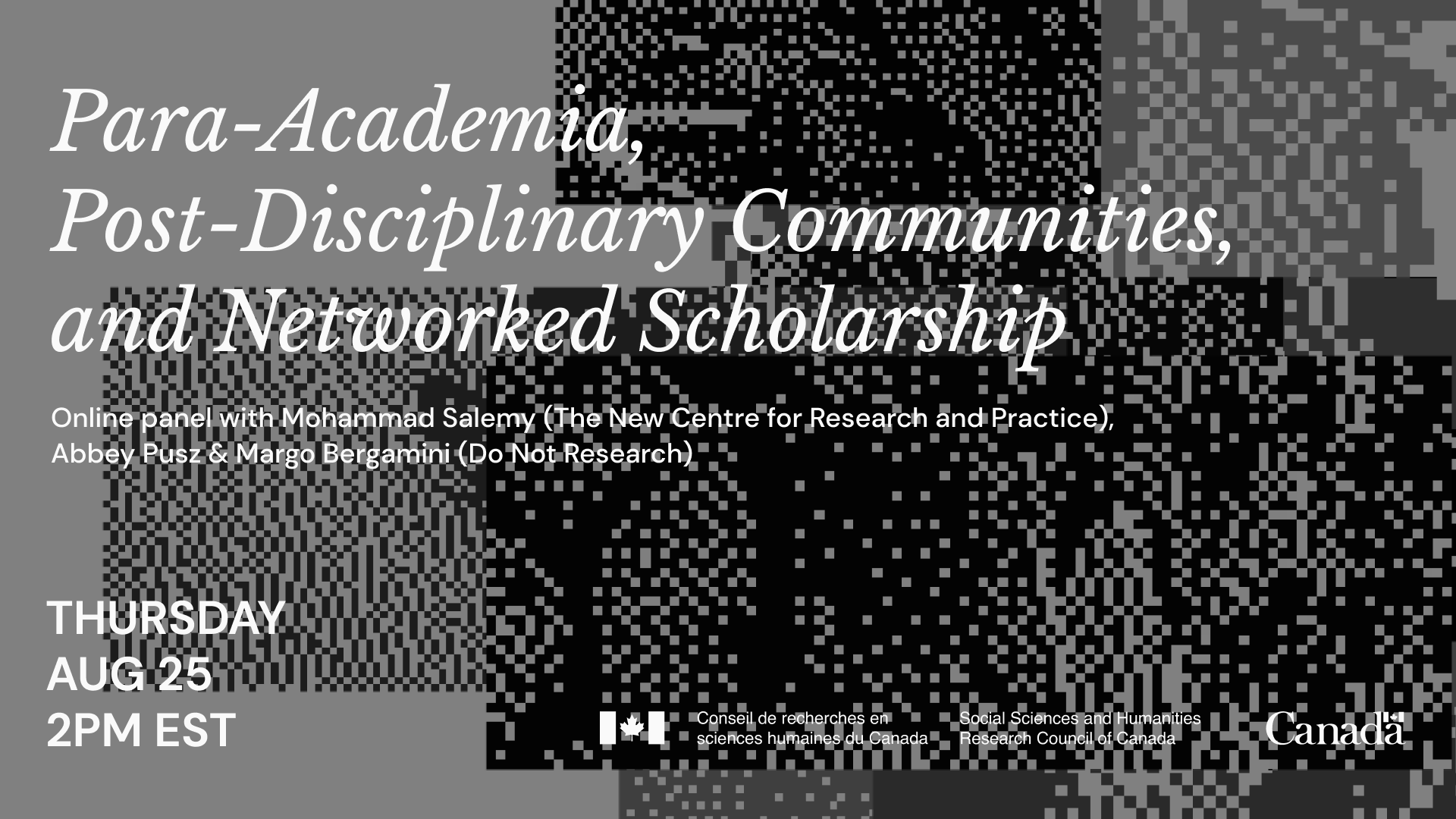
-
20/08/2022
Museums Without Walls exhibition
Art and Media Lab, Isabel Bader Centre for the Performing Arts
390 King Street West, Kingston, ON
Visiting hours: Aug 15-20, 12-4pmPart of a larger survey on virtual art institutions and communities, the Museums Without Walls exhibition gathers projects that attempt to reimagine our modes of cultural engagement, access, and preservation using media as diverse as publications, interactive videos, and simulated environments.
Participating artists and initiatives include Ana Valine, Camille Henrot, Diogo de Moraes Silva, Écran Total, Gallery 404, Mari Nagem, Michael Lou, Museum of Other Realities, paula roush & msdm, SystemKollectiv, The Broken Timeline, The Zium Society, Velcro Ediciones , and Zentrum für Netkunst.
Special visiting hours during the Museums Without Walls conference. On Monday Aug 15, at 6pm, there will be an opening with a catalogue launch covering the activities of first year of the project.
Museums Without Walls is supported by the Social Sciences and Humanities Research Council, Queen’s University, Screen Cultures and Cultural Studies Program, and the Agnes Etherington Art Centre.
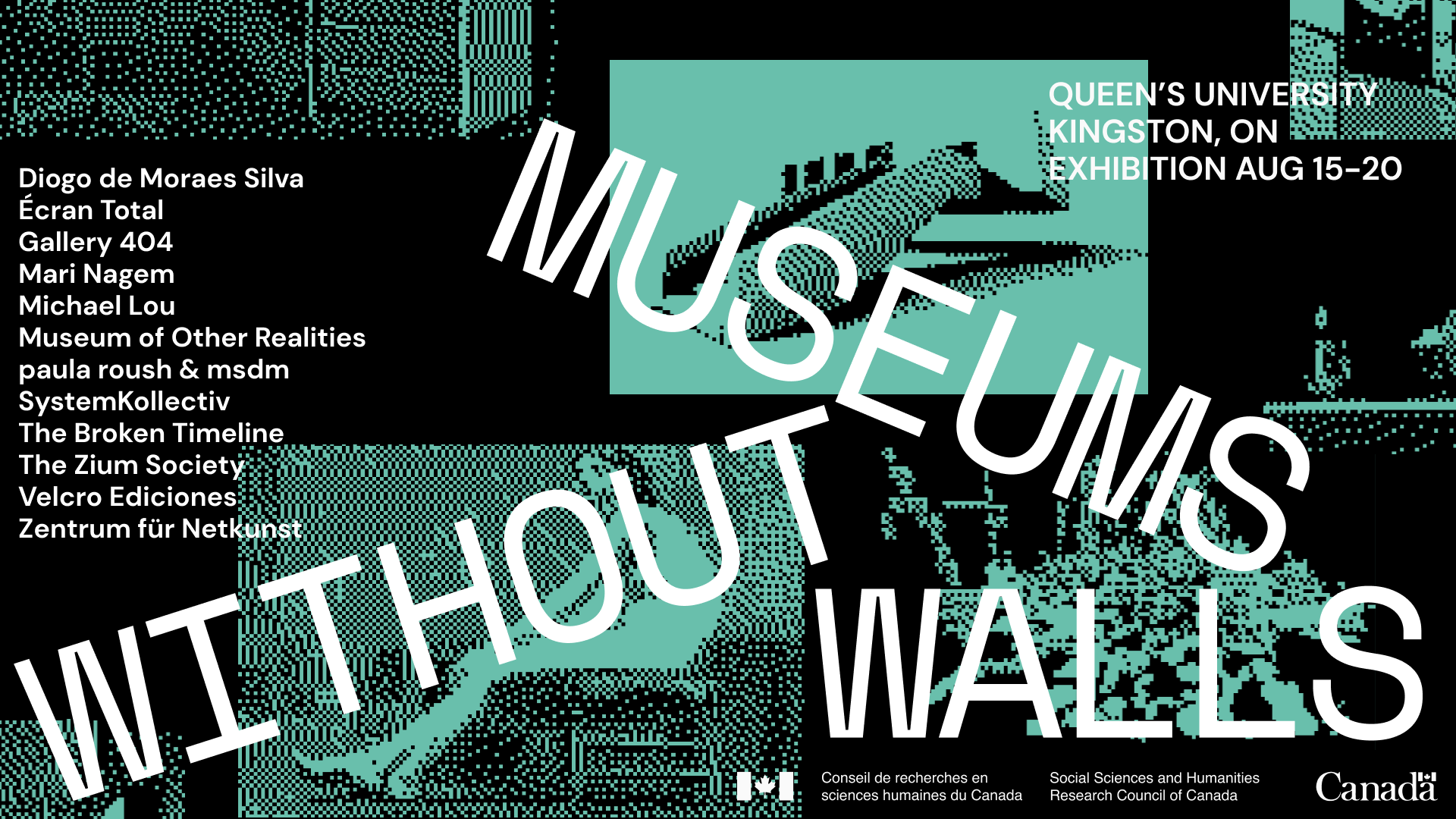
-
15/08/2022
Museums Without Walls conference & exhibition
Queen’s University, Kingston, ON
Aug 15-17Check the full program here, and register here to participate.
In the spirit of critical and social museology, the Museums Without Walls conference invites us to reclaim notions of virtuality from the technopositivist buzz and revisit the long history of relationships between museums and media.
The many contributions to the event open space for the discussion and exercise of new configurations for art institutions amidst other information technologies. They propose further ways to dispute ossified narratives and account for overlooked artforms; access and engage with collections; return cultural artifacts to the spheres of circulation; take care of the publics, their histories, circumstances, and modes of expression.
The conference is accompanied by a week-long exhibition that gathers projects that reimagine our modes of cultural engagement, access, and preservation, using media as diverse as publications, interactive videos, and immersive environments.
Keynotes by Michael Connor (Rhizome), Sarah Kenderdine (Experimental Museology Lab / EPFL), Pippin Barr (Concordia University), and Sara Diamond (OCAD University).
The event also counts with the participation of: George Oates (Flickr Foundation); Luisa Ji & Jerrold McGrath (UKAI Projects); Teodora Fartan (CSNI/LSBU); Katharina Niemeyer (UQAM); Blake Fall-Conroy & Nimrod Astarhan (Art Institute of Chicago); Treva Legassie (Concordia University); paula roush (CSNI/LSBU); Aarati Akkapeddi; Brandie MacDonald (Museum of Us); Chao Tayiana Maina (African Digital Heritage); Danuta Sierhuis & Jennifer Nicoll (Agnes Etherington Art Centre); Jennifer Kennedy (Queen’s University); Michael Carter-Arlt (Toronto Metropolitan University); Mikayla Brown (Temple University); Su-Anne Yeo (University of British Columbia); Elina Lex (Concordia University); Diego Rotman (The Hebrew University of Jerusalem); Lea Mauas (Queen’s University); Catalina Alvarez, Liz Flyntz & Leander O’Connell Johnson (Ant Farm Antioch Art Building Creative Preservation Initiative); Bethany Berard (Carleton University); Sarah E.K. Smith (Western University); Ellie Décary-Chen, Lucas LaRochelle & Prakash Krishnan, Heather Mitchell (Things+Time); Jung-Ah Kim, Peggy Fussell, Tia Bankosky, Prerana Das, Drew Burton, Jessa Laframboise, Anna Douglas (Queen’s University); Ana Valine; Camille Henrot; Diogo de Moraes Silva; Gallery 404; Mari Nagem; Michael Lou; Museum of Other Realities; SystemKollectiv; The Broken Timeline; The Zium Society; Velcro Ediciones; and Zentrum für Netkunst.
Museums Without Walls is supported by the Social Sciences and Humanities Research Council, Queen’s University, the Screen Cultures and Cultural Studies Program, and the Agnes Etherington Art Centre.
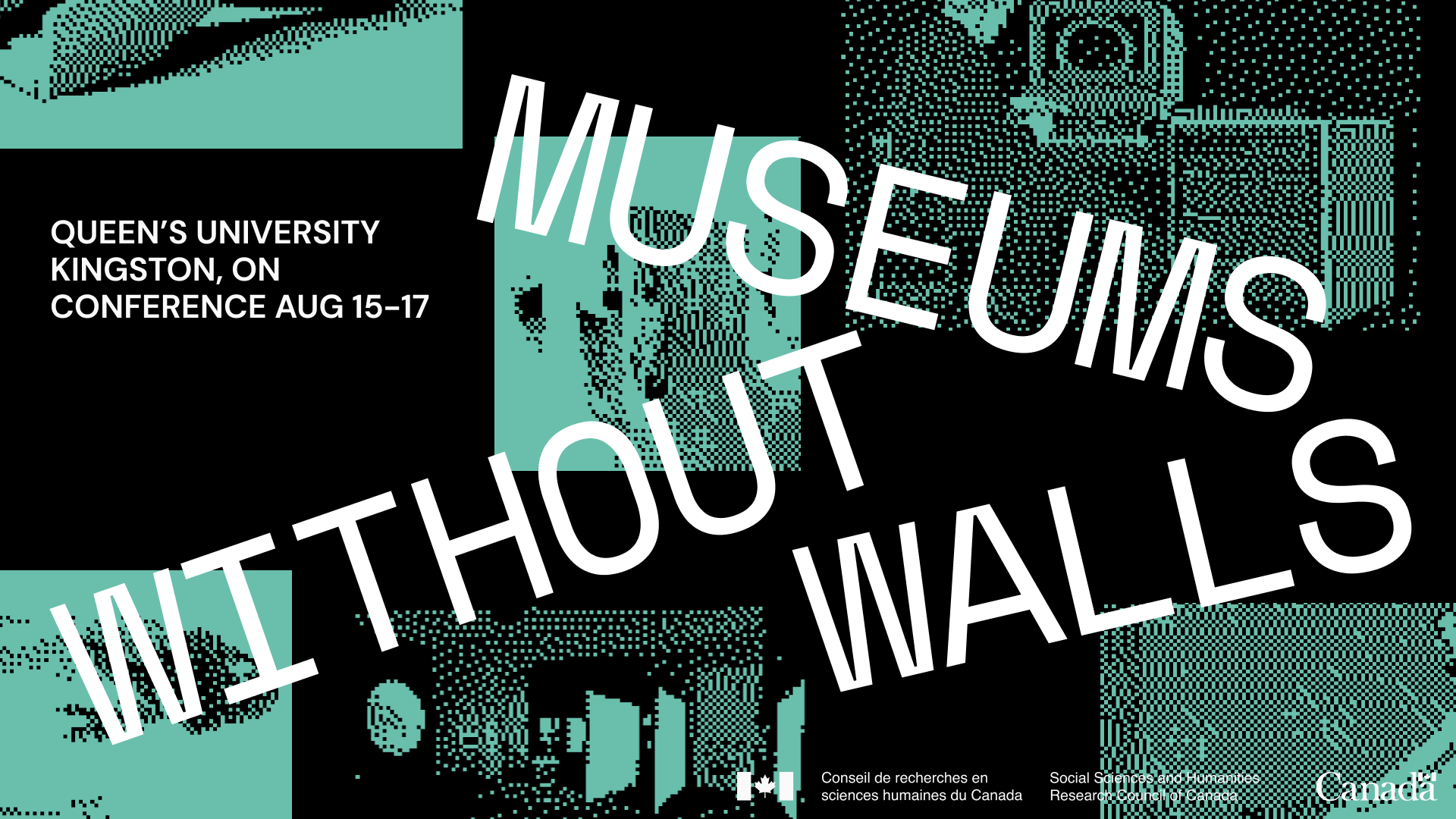
-
28/07/2022
“Dis/embodied Audio-visual Collage” online workshop
Register to participate on Zoom.
The Museums Without Walls 2022 program begins next week with the online workshop Dis/embodied Audio-visual Collage: Collective World-Building with Daniel Lichtman.
In this workshop, participants will work together to produce an interactive 3D environment composed of audio recordings and photographic fragments of participants' immediate, physical surroundings. Over the course of the workshop, participants will capture audio and photographic source material and work together to compose this material into a 3D scene using the Unity game engine and the Community Game Development Toolkit. Participants will then collectively explore the resulting environment as avatars, charting a network of chance encounters with disembodied audio-visual fragments of participants’ surroundings as they move through the virtual space. Each play-through of the scene will yield a unique path through this collaboratively produced collage, representing a unique, virtual composition of participants’ collective experience of space, material and sound.
The Community Game Development Toolkit is a set of tools that make it easy and fun for students, artists, researchers and community members to create their own visually rich, interactive 3D environments and story-based games without the use of coding or other specialized game-design skills. The toolkit provides intuitive tools for members of diverse communities to represent their own traditions, rituals and heritages through interactive, visual storytelling.
-
30/04/2022
Call: Museums Without Walls – Conference & Exhibition
An inquiry into virtual art / institutions and communities
Queen’s University, Ontario, August 15-17 + OnlineSubmissions: https://forms.gle/Y9SKgiKg6u2Wzm1L6
Deadline: April 23The global pandemic has laid bare the technological crossroads where cultural institutions find themselves in the early 21st century. By promoting a superabundance of ‘content’ and multiplying the transversality of connections, digital networks have increasingly undermined the authority of museums as sites for memory preservation, collection stewardship, and discourse reproduction. All the while, new media systems keep promising to expand the museal apparatus and radically transform the ways in which art institutions can perform their mandates and operate within society.
Has the modern project of the museum finally come to its terms? Can future forms of socio-cultural institutionality be found among online databases, simulated environments, social media communities, smart contracts, and other computer platforms?
These questions invite us to reclaim notions of virtuality from the technopositivist buzz and revisit the long history of relationships between museums and media. In the spirit of critical and social museology – and particularly interested in non-Western perspectives –, the Museums Without Walls conference seeks to open a space for the discussion and exercise of new configurations for art and cultural institutions.
We are looking for proposals of papers, talks, workshops, publications, exhibitions, websites, movies, and other forms of artworks that engage with subjects such as:
- Museums and/in virtual realities
- Uses of new and old media systems and VR/AR/XR for cultural access and documentation
- Online / virtual exhibitions, arts residencies, and other forms of public outreach
- Technopolitics in/of galleries, libraries, archives and museums
- Art institutions as discursive, knowledge, and informational frameworks
- Interfaces for art and artifact collections
- Museum projects in simulated, digital, and gaming environments
- Publications and merchandise as extensions of institutional activities
- Printed, broadcasted, and streamed exhibitions
- Audiotours, videoguides, and other interactive forms of mediating artist practice
- Cultural management and curatorial strategies in the age of computer networks
- Possibilities of collaboration and dissent enabled by online platforms
- Counterpublic appropriations and the unsettling of museal spaces
- Performances of monumentality using media and XR technologies
- The mediation of absences and struggles for re/depatriation
- Multi-user web platforms as exhibition sites (Mozilla Hubs, New Art City, common.garden, etc)
- Public repositories of museal data (Google Arts & Culture, Smithsonian Open Access, Scan the World, etc)
- Rogue 3D scanning and other digital bootlegs
- Art institutions in the ‘metaverse’
The Museums Without Walls conference takes place at Queen’s University, Ontario, between August 15-17. The conference will intersect with the Summer Institute: The Curatorial organized by the Agnes Etherington Art Centre and Queen’s Screen Cultures and Curatorial Studies program, and it will be completely free to attend and participate. A number of online activities will precede and follow the event.
Submit your proposals by April 23 using the link: https://forms.gle/Y9SKgiKg6u2Wzm1L6.
Proposals consist in an abstract/synopsis (100-250 words), short author’s bio (100 words), and links to supporting material. When submitting, please indicate whether your proposal is for presentation online and/or on site at Queen’s, during the days of the conference. For workshop and artwork proposals, please include links to relevant documentation as well as technical and installation requirements. Submit any questions to museusemparedes@gmail.com.
Museum Without Walls is supported by the Social Sciences and Humanities Research Council of Canada.
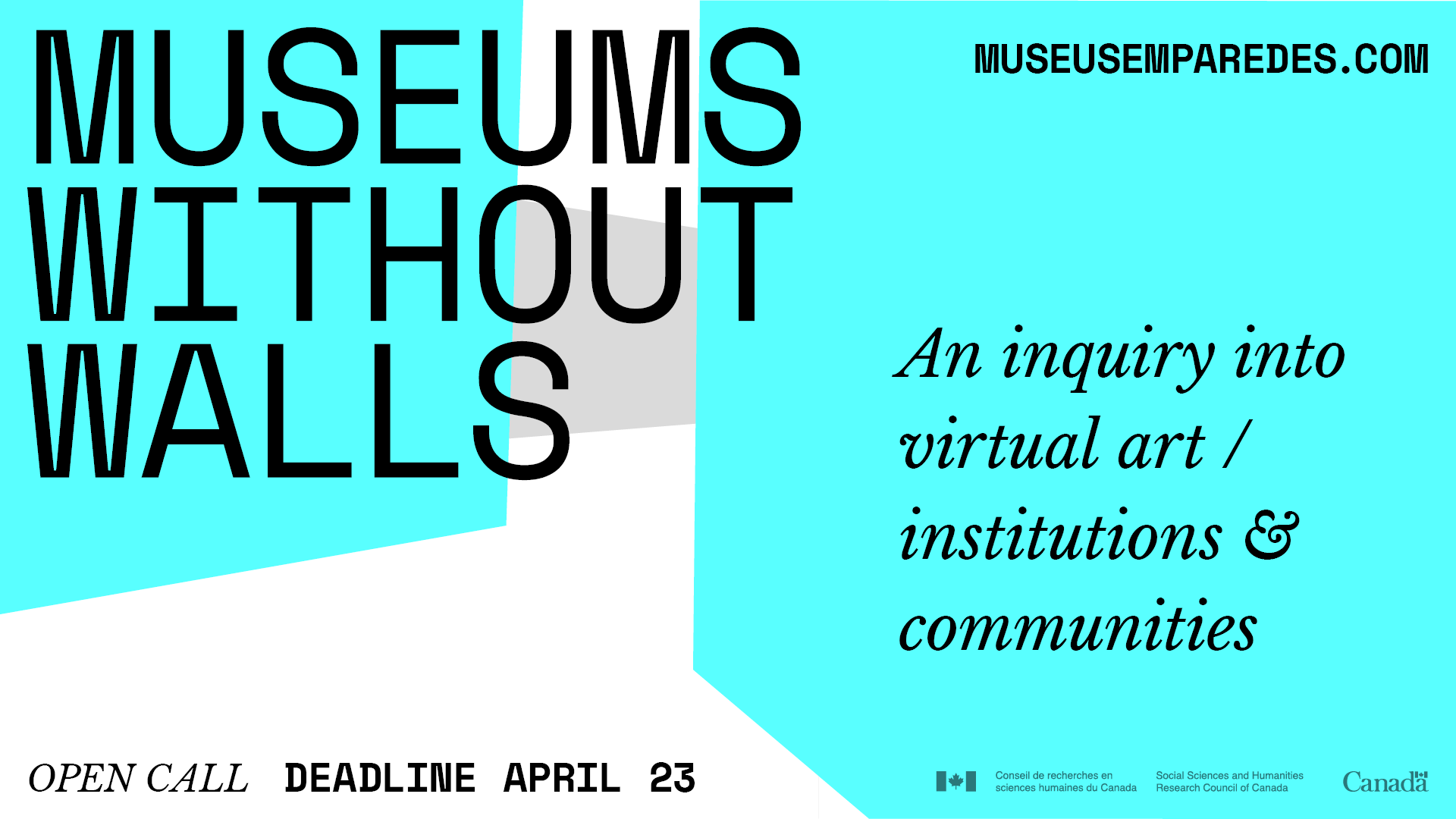
-
30/07/2021
AFAAB Summer Program
This summer, the virtual Ant Farm Antioch Art Building will be teeming with activities! Come attend a karaoke show, a guided tour, a screening program and an exhibition on this WebVR version of the venue, constructed from 1971 archival architect’s drawings.
- James Frederickson Memorial Karaoke Show, July 13, 7pm EST - REGISTER
- AFAAB Open House, July 19, 6pm EST - REGISTER
- Film Screening: Starless and Outskirts, July 23, 6.30pm EST - REGISTER
- Menagerie by Michael Perea, July 30, 7pm EST - REGISTER
Participation is free but places are limited. Register in advance at punk-preservation.eventbrite.com.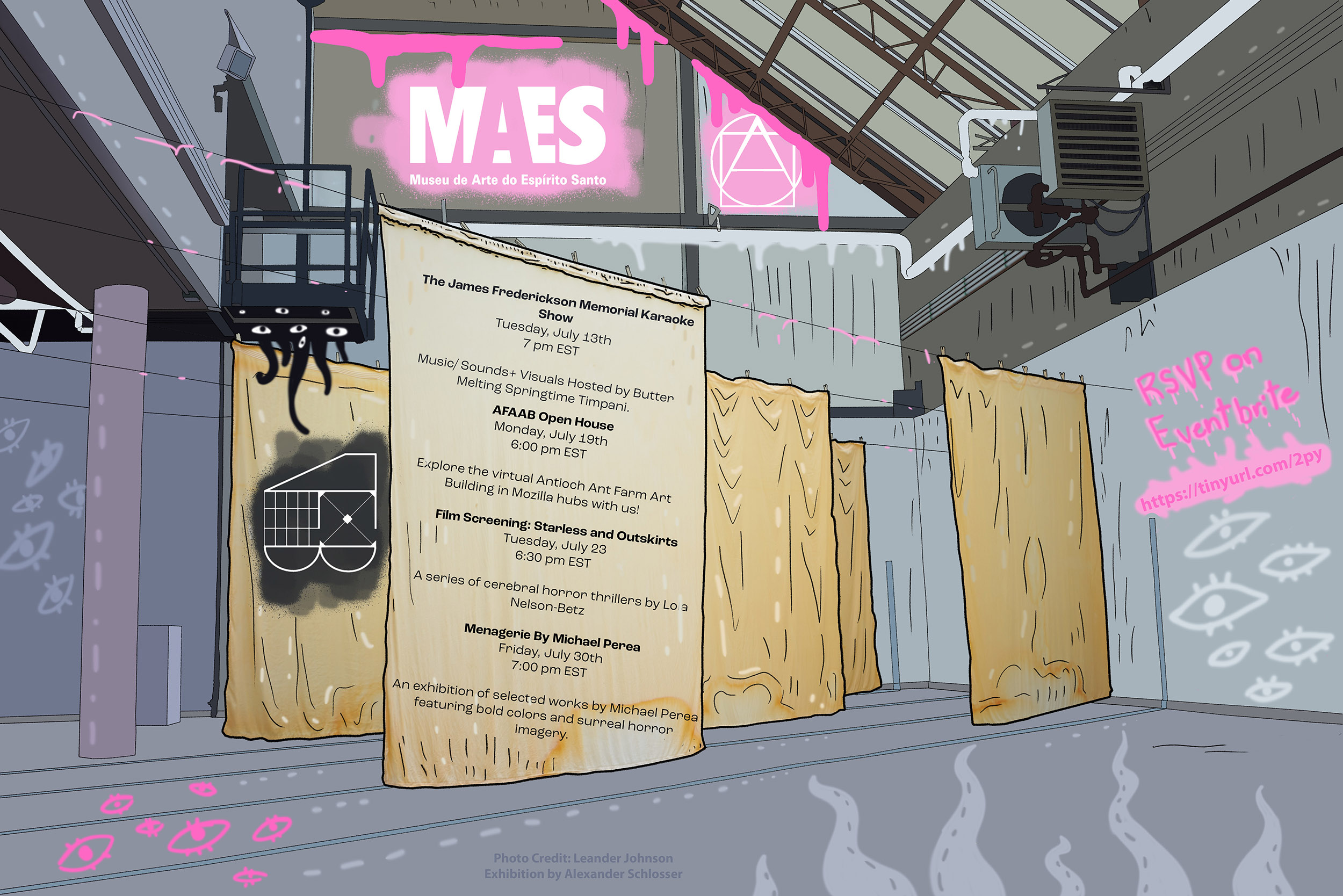
-
01/07/2021
Rigor Mortis Party
Thursday, July 01, 6pm EDT
at hubs.mozilla.com/GG79F5PZombie Party Guide: Jye O'Sullivan

-
26/06/2021
guided virtual tours across other MAES
This Saturday, come for live, guided tours with artists and curators of two virtual versions of the Espirito Santo Art Museum that extrapolate its building and completely recreate the institution!
"The Ant Farm Antioch Art Building in VR" recreates the spirit of the original place, designed by radical architects and Ant Farmers Doug Michels and Tom Morey and built in 1971 out of local off-the-shelf components.
Where? https://hubs.mozilla.com/TGQ5vJ8
When? Saturday July 26, 5pm EST
Register at Eventbrite."Non-Space I" seeks to displace and reformulate the social aspect of the WebVR space. Employing verticality, mirroring as well as dislocation of the voice and images of viewer inhabited avatar bodies, it teases out other possibilities of social interaction to be explored.
Where? https://hubs.mozilla.com/ZkthWS8
When? Saturday July 26, 6pm EST
No registration necessary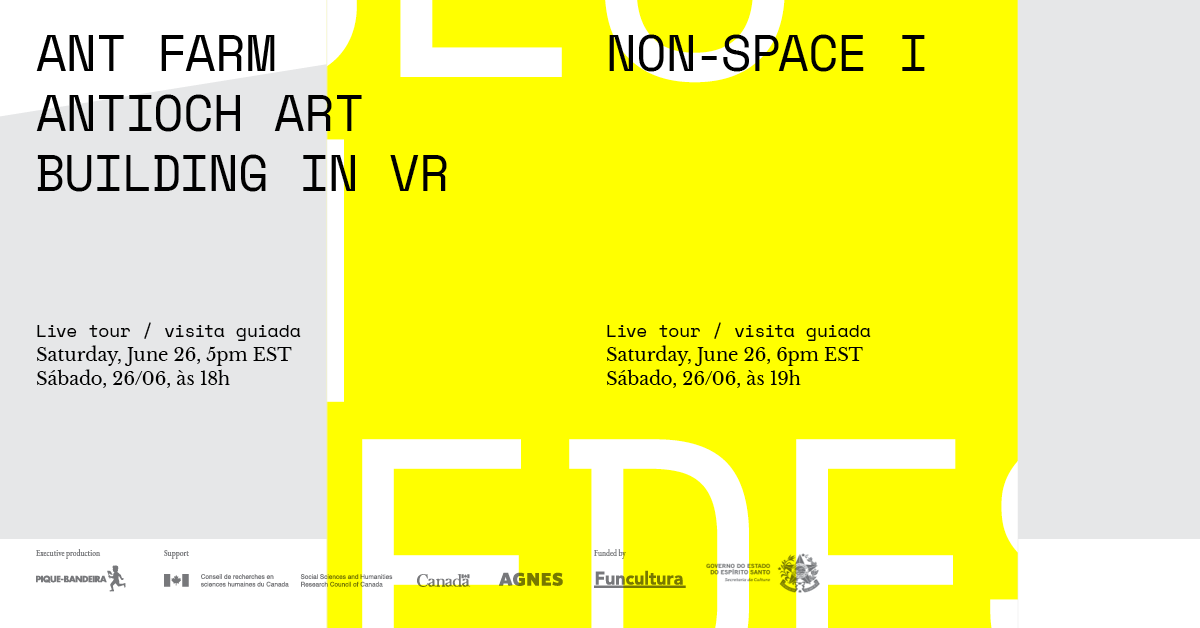
-
24/06/2021
!PUFF! live concert in VR
June 24, 8-10pm EST, online.
Places limited. Register free at Eventbrite.Conor Jameson's !PUFF! / Bad Attitude: Singing the character, and the "Bubble Grunge Vignettes" is a collaborative concept album blending music and fiction to depict the lives of seven women through a musical EP and anthology of flash fiction.
The live concert will be presented simultaneously at the Ant Farm Antioch Art Building in VR.
AFAAB is a collaborative multi-disciplinary project to preserve both the physical structure and the spirit of the Antioch Art Building, designed by radical architects and Ant Farmers Doug Michels and Tom Morey and built in 1971 out of local off-the-shelf components.
Over the next months, the VR version of the AFAAB will be open for exploration, performance, and conversation. Inside you’ll find an exhibition of distressed archives, speculative architecture, utopian musings, and a recursive video portal to the real art building.
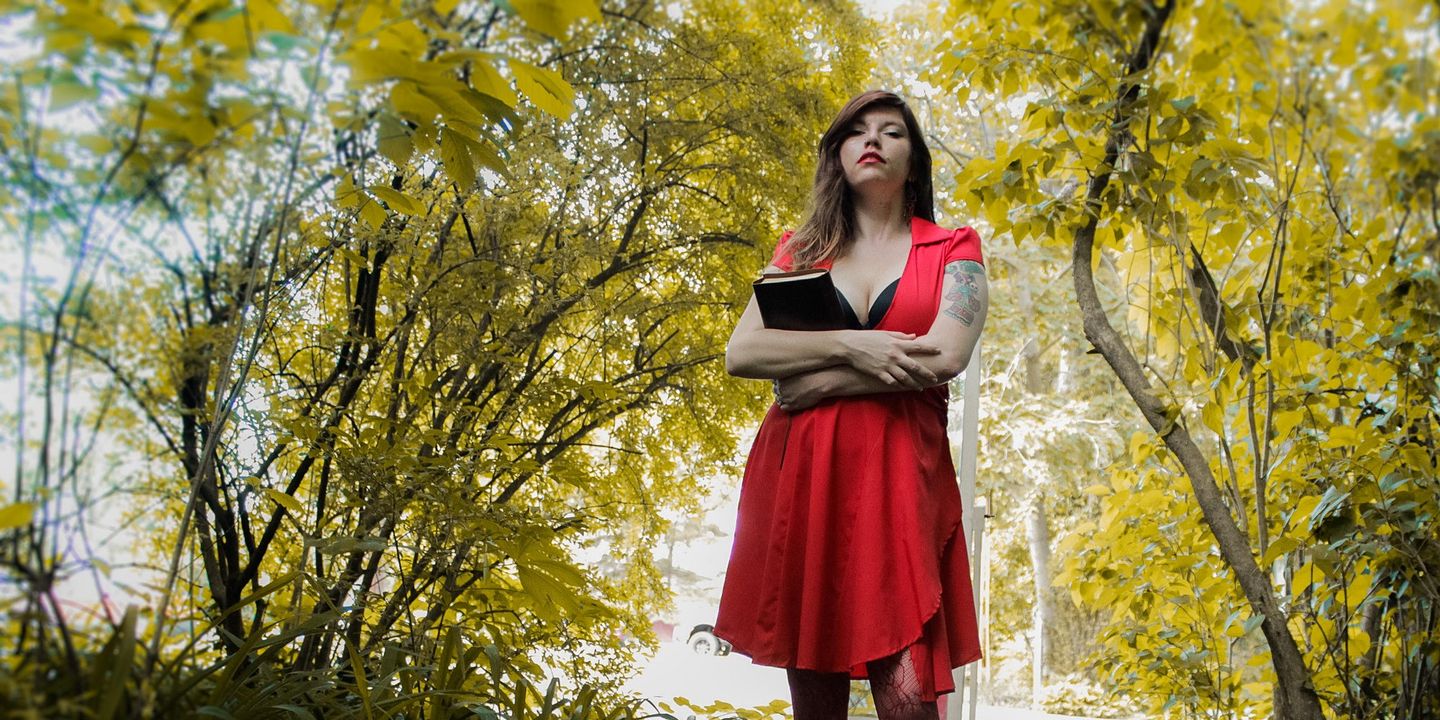
-
18/06/2021
Poetics of World Building
Talk with Jawa El Khash
June 18h, 10am EST, onlineRegister free at https://bit.ly/2RXZXtv
Jawa El Khash is an artist, researcher and technologist. She works in VR, holography and painting, currently based in Toronto. Her practice is focused on the art and poetics of VR narrative and environmental storytelling. In this talk, El Khash will be taking the audience through her work, thought process and artistic approach to world building.
This talk is presented by the Agnes Etherington Art Centre.
Image: The Seed Vault (© Jawa El Khash, 2021)
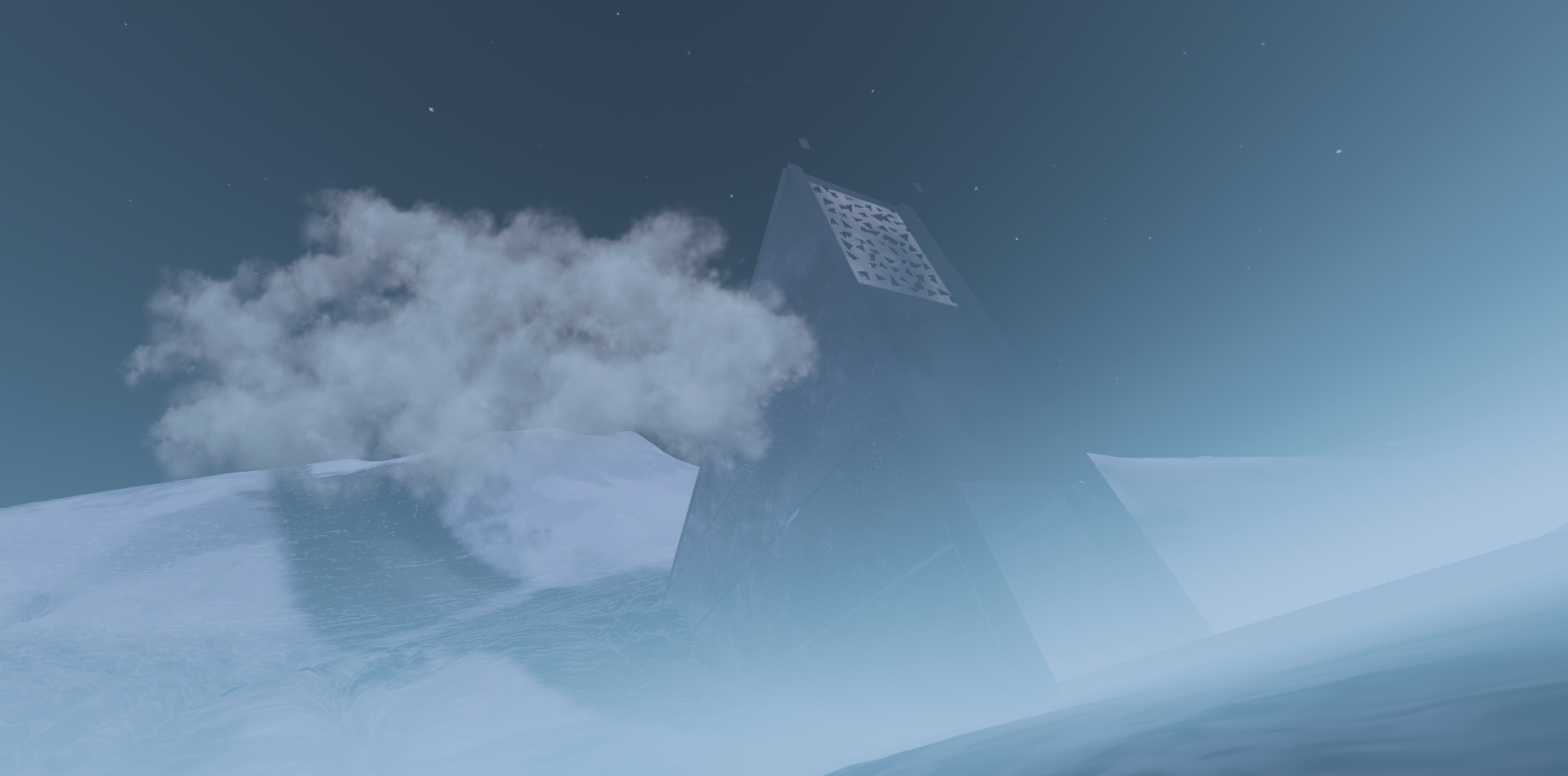
-
28/05/2021
Virtual Places for Critical Immersion and Collaborative Knowledge
Workshop with Alexandra Antonopoulou and Eleanor Dare
May 28h, 10am EST, onlineIn the framework of the Museum Without Walls project, this workshop examines how virtual spaces can become places for knowledge generation and collaboration. Artist-researchers Alexandra Antonopoulou and Eleanor Dare will share their experiences in the decade long Phi Books, a writing project engaged with human and non-human creative collaboration, generating forms of visual, sonic, animated, and embodied storytelling. They will explore how to deploy technologies as heuristics for collaboration and how to position virtual spaces as horizontal non-predetermined structures. They will also convey an ‘immerticritical’ - immersive and critical - approach towards technology, language, and image-making. At the end, participants will be able to originate their own collaborative methods and experimental storytelling forms, with analogue and digital ‘agents’ supporting the process across self-defined dimensions.
ELEANOR DARE is a creative technologist with a PhD and MSc from Goldsmiths Department of Computing as well as an MA in Creative Writing. Eleanor's research is concerned with the limits of symbolic logic, representation, creative non-fiction as well as the implications of virtual reality. Eleanor's published writing critiques the neoliberal ideology of Smart Cities and AI reductionism as well as the colonialism of Design Thinking. Eleanor has taught computer programming and themes relating to digital theory at Goldsmiths, the University of Derby, the Open University, UCL, RCA and the University of the Arts. In the last two decades Eleanor has exhibited many digital artworks and has published numerous book chapters and peer-reviewed papers addressing computation, AI, emerging narrative and systems of knowledge. These include chapters in MIT’s Leonardo, as well as presenting pedagogic papers at Cambridge University’s Faculty of Education. Eleanor was formerly Reader in Digital Media and Head of Programme at the Royal College of Art.
ALEXANDRA ANTONOPOULOU is a UK based designer and a Course Leader at the University of the Arts London. Alexandra has also taught design, story-making and immersive environments modules at Goldsmiths and the Royal College of Art. Her work engages with wider discourses on art and design pedagogy, myths and fairytales, interdisciplinary collaboration, and science communication. Her artistic practice has been showcased in various galleries including the Victoria and Albert Museum, the Tate Modern Gallery and the London Design Museum. Her research examines child-play as well as story-making, performance and design as tools for criticality and everyday invention. Alexandra Antonopoulou holds a Ph.D. in Design from Goldsmiths.
Image: Phi Books (© Antonopoulou & Dare)
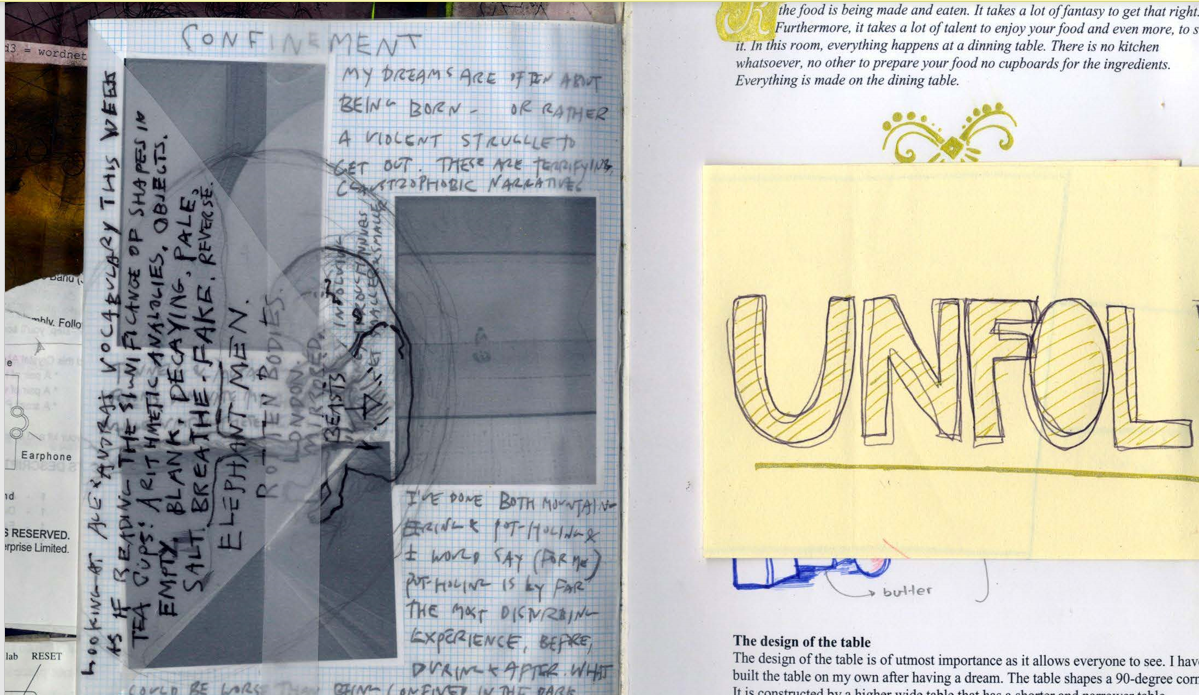
-
10/04/2021
Selected proposals – VR Residency
The project Museum Without Walls presents the proposals selected for its Virtual Reality Residency Program. Throughout Abril and May, the participating residents will develop different versions of the Espírito Santo Art Museum - MAES in the virtual reality Mozilla Hubs platform. The creation processes will be shared on this page, and the final results will be presented by the end of May, along with the new Museum Without Walls website.
- Commonolithic
Tom Watson - Rigor Mortis
Renato Pera - The Space Expanding Room
Catalina Alvarez e Liz Flyntz - Você é a encruzilhada das suas memórias
Garu, Pedra Silva, Rodrigo Lopes
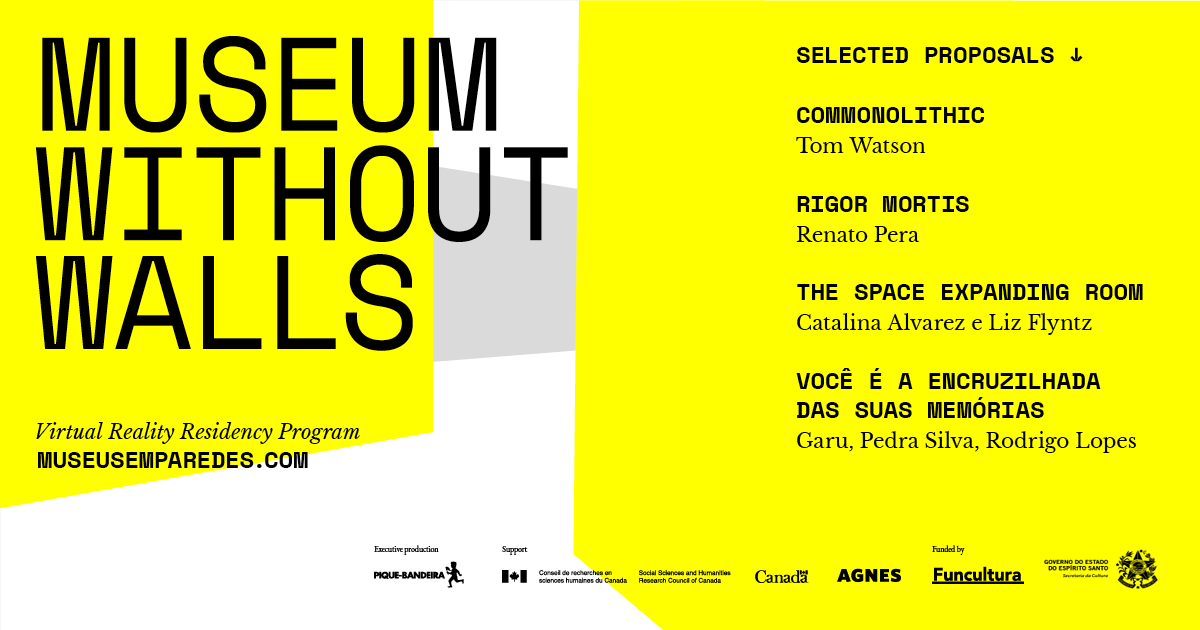
- Commonolithic
-
01/03/2021
Call for proposals: VR Residency Program
VISIT HERE THE VIRTUAL MAES MUSEUM
Museums Without Walls is seeking proposals for its virtual reality residency program. Residencies will take place through April and Mayin different versions of the Espírito Santo Art Museum – MAES hosted in the Mozilla Hubs platform. Four participants will be selected to occupy and recreate this environment based on their artistic and/or curatorial visions. The selected proposals will receive specialized mentorship and a development fee of CAD $ 600. The residency outcomes will be presented in the Museum Without Walls program in late May.
MAES is situated in the Southeast coast of Brazil. Museum Without Walls takes inspiration from its recent reopening, after a long reform which recuperated elements of the museum’s original architecture while making the exhibition space much more susceptible to its surroundings. Amidst the global pandemic, the project invites us to examine how art institutions operate, both within and without their physical buildings, as systems for representation and discourse.
Virtual Reality technologies provide new opportunities to reconfigure the terms of relationship between artwork and space – experience and object – public and institution. These technologies may pluralize the access to conventional artforms, cultivate digitally-native poetics, and accomplish other distributions of the sensible. We are looking for proposals that creatively engage with technological contingencies and exercise virtuality as a potential for reimagining the museum.
Mozilla Hubs is a multi-user virtual reality platform with a fairly low learning curve. On top of that, it is compatible with both regular browsers and the last-generation VR headsets. The choice to host this residency in Hubs is meant not only to amplify possibilities of participation, but also to emphasize the social dimensions of the museum as a public infrastructure. Proponents are encouraged to get acquainted with the platform and visit some of the exhibitions made in it before submitting their proposals.
Apply by sending the following documents to info@museusemparedes.com by March 29:
- CV (text format – docx / rtf)
- Illustrated PDF portfolio and/or website link
- Artistic or curatorial proposal (500 words description, followed by a list of links to relevant references, such as participating works/artists and concept sketches)
The Museum Without Walls residency program is committed to the diversity of publics as well as to free and open methodologies. The project is funded by the Espírito Santo State Cultural Offices and by the Canadian Social Sciences and Humanities Research Council, and counts with the support of the Agnes Etherington Art Gallery.

Museum without Walls
Museum without Walls
Museum without Walls
Since the community was being used as a construction site for the Olympic Park - one of the strategies used to pressure residents and compel families to accept the proposal of the City of Rio de Janeiro -, the sculpture “Suporte dos Males” and part of the sculpture “Espaço Ocupa e Casa da Dona Conceição” were destroyed by tractors.

You are the crossroad of your memories - Born from clay and modelled in 3D, this installation is composed by a virtual room, a performance program and a digital publication. Its shape, inspired by the moringa, an object used by aboriginal peoples for storing and cooling water, is a reminder and an invitation: a reminder that without its union with natural elements, our existence would not be possible; and an invitation to play with the porosity of memory, identity and body. Concept and realization: Pedra Silva, Garu e Rodrigo Lopes.
